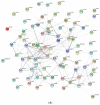Potential Tear Biomarkers for the Diagnosis of Parkinson's Disease-A Pilot Study
- PMID: 35076620
- PMCID: PMC8788479
- DOI: 10.3390/proteomes10010004
Potential Tear Biomarkers for the Diagnosis of Parkinson's Disease-A Pilot Study
Abstract
Parkinson's disease (PD) is the second most common neurodegenerative disease after Alzheimer's disease. In this study, the tear proteome profile of patients with idiopathic PD (iPD, n = 24), carriers of the E46K-SNCA mutation (n = 3) and healthy control (CT, n = 27) subjects was analyzed to identify candidate biomarkers for the diagnosis of PD. An observational, prospective and case-control pilot study was carried out, analyzing the participants tear samples by nano-liquid chromatography-mass spectrometry (nLC-MS/MS) and assessing their neurological impairment. The proteomic data obtained are available at ProteomeXchange with identifier 10.6019/PXD028811. These analyses led to the identification of 560 tear proteins, some of which were deregulated in PD patients and that have been implicated in immune responses, inflammation, apoptosis, collagen degradation, protein synthesis, defense, lipid transport and altered lysosomal function. Of these proteins, six were related to neurodegenerative processes and showed a good capacity to classify patients and controls. These findings revealed that certain proteins were upregulated in the tears of PD patients, mainly proteins involved in lysosomal function. Thus, in this study, tear proteins were identified that are implicated in neurodegeneration and that may be related to an aggressive disease phenotype in PD patients.
Keywords: Parkinson’s disease; biomarkers; lysosome; tear film.
Conflict of interest statement
The authors declare no conflict of interest. None of the authors has received funding from any institution, including personal relationships, interests, grants, employment, affiliations, patents, inventions, honoraria, consultancies, royalties, stock options/ownership or expert testimony in the last 12 months.
Figures




References
-
- Satake W., Nakabayashi Y., Mizuta I., Hirota Y., Ito C., Kubo M., Kawaguchi T., Tsunoda T., Watanabe M., Takeda A., et al. Genome-wide association study identifies common variants at four loci as genetic risk factors for Parkinson’s disease. Nat. Genet. 2009;41:1303–1307. doi: 10.1038/ng.485. - DOI - PubMed
Grants and funding
LinkOut - more resources
Full Text Sources
Miscellaneous

